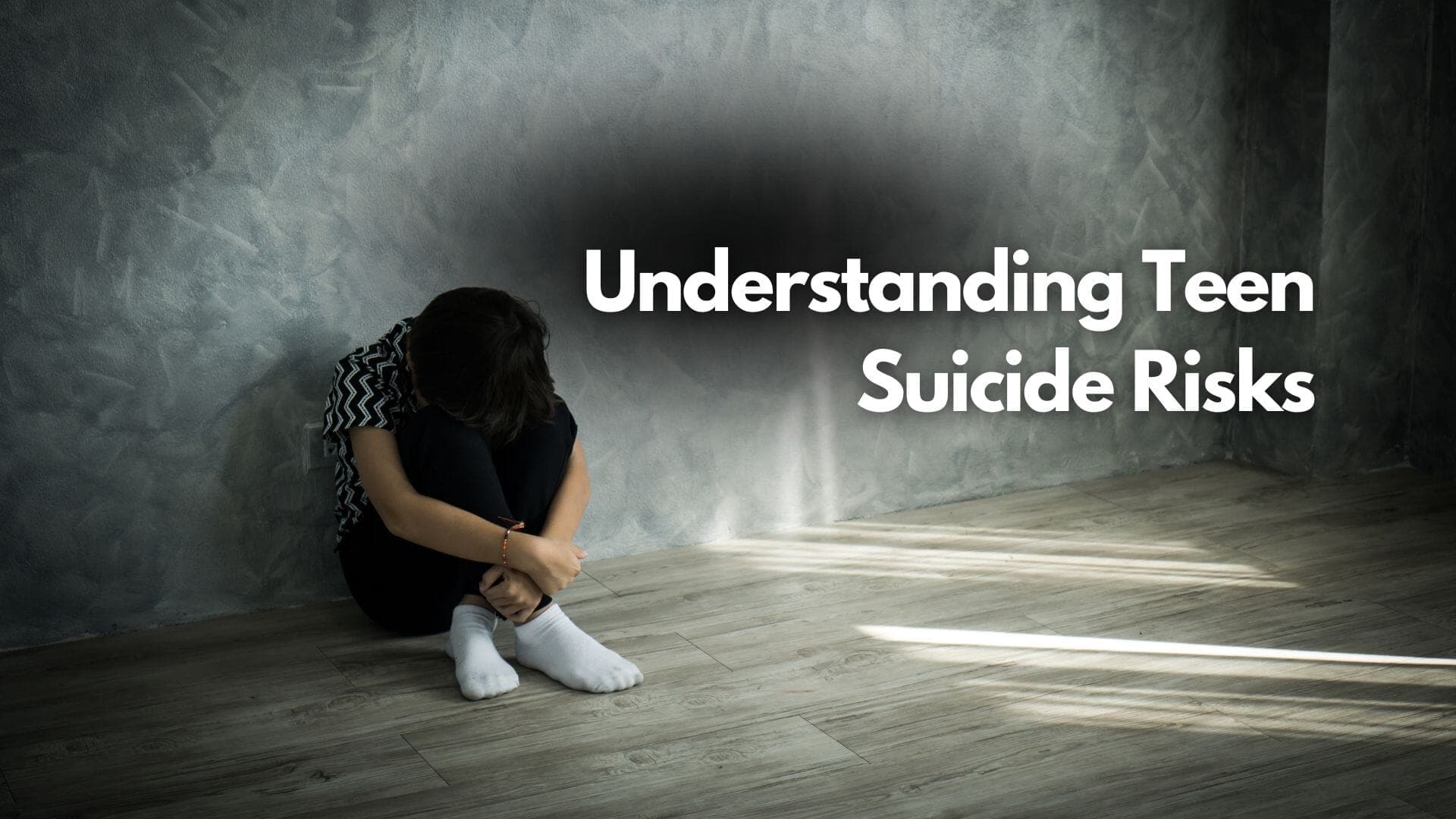The teen years bring unique challenges, and in today’s digital world, understanding and supporting teens’ mental health has become more crucial than ever. Our recent Cyber Safety Cop webinar, “Understanding and Preventing Teen Suicide,” tackled this pressing topic with mental health expert Susan Parmelee. Together, we explored the mental health landscape for teens and provided parents and caregivers with actionable strategies for support. We urge all parents and guardians to watch this essential webinar—it’s an invaluable resource to help you understand the risks, recognize the signs, and support your teen’s mental well-being.
Teen mental health has become a national concern. Recent studies show that anxiety, depression, and suicidal ideation among teens have risen significantly. According to Susan Parmelee, a licensed clinical social worker, nearly 25% of high school seniors report thoughts of suicide within a month, with pressures like academics, college admissions, and the demands of “adulting” often playing a role. Today’s teens also face increased social pressures, amplified by a culture of constant online comparison, which can worsen mental health struggles.
The Impact of Social Media and Technology on Teen Mental Health
The digital revolution of the last decade has transformed how teens interact with each other and the world. While technology has brought convenience, it has also introduced new challenges for mental health. Studies reveal that social media significantly impacts teens’ mental well-being, particularly through comparison and peer pressure. Girls often gravitate toward social media, which can lead to increased self-comparison, while boys may spend more time gaming, which may limit real-life social interactions and opportunities for conflict resolution.
The Adolescent Brain Cognitive Development (ABCD) Study has shown that early screen exposure can impact brain development, affecting creativity, reasoning, and memory in ways still being understood. To manage these challenges, Susan recommends introducing technology thoughtfully and supporting healthy boundaries with screens.
Recognizing Warning Signs of Mental Health Struggles in Teens
Recognizing the signs of mental health struggles is a key step toward providing support. Red flags may include:
-
Withdrawing from hobbies or activities they once enjoyed.
-
Changes in personal hygiene and appearance.
-
Academic decline or other performance shifts.
-
Altered sleep patterns or excessive fatigue.
Pay attention to changes in your teen’s baseline behavior; Susan emphasized that parents are often the best judges of what’s “normal” for their child.
Practical Strategies for Parents and Caregivers
Starting Mental Health Conversations
Opening up a conversation about mental health can feel daunting, but Susan suggests beginning with simple, genuine questions. Show vulnerability by sharing your own emotions in age-appropriate ways. Create regular check-in opportunities, like family dinners, where everyone can share highs and lows, fostering a sense of normalcy around mental health topics.
Managing Screen Time
The American Academy of Pediatrics and the National Institutes of Health emphasize limiting screen exposure for young children and encourage parents to prioritize high-quality, interactive content when introducing screens. Susan suggests aiming for less than two hours of screen time per day for teens, focusing on balancing tech use with other activities.
To help parents manage these boundaries, apps like OurPact offer powerful features to set limits, monitor usage, and keep digital experiences safe. OurPact is a comprehensive parental control app that allows parents to schedule device usage, set daily screen time limits, and block specific apps or websites. With options to monitor content, block inappropriate websites, and instantly grant or restrict access, OurPact puts control back in the parents’ hands. It also tracks real-time location and provides geofencing alerts, notifying parents when their child enters or exits designated areas, adding another layer of safety.
The app’s “View” feature allows parents to remotely view their child’s device screen through periodic screenshots, offering insight into their child’s digital activity, including apps, messages, and web content. This feature, which can be customized for frequency, helps parents proactively address any concerns by seeing what their child is engaging with and ensuring it aligns with safe, responsible use.
OurPact empowers parents to set healthy screen boundaries that support balanced digital habits. In a world where excessive screen exposure can impact mental well-being, academic performance, and social skills, this app provides peace of mind and practical oversight. By encouraging responsible digital habits, OurPact enables parents to safeguard their child’s online experience while promoting essential offline activities like schoolwork, family interactions, and adequate rest.
Cyber Safety Cop also offers detailed, free eBooks on apps like Instagram, Snapchat, and TikTok, providing guidance on settings, parental controls, and safe use. These resources are ideal for parents unfamiliar with these platforms, allowing them to support their teens safely in the digital world.
Encouraging Offline Activities
Encourage teens to spend time outside or engage in unstructured, creative play, as physical activity and hands-on hobbies can relieve stress and support social skills. Group activities like sports or martial arts, provide healthy outlets for teens to channel their energy and develop self-discipline.
Addressing the Stigma and Building a Support System
Mental health discussions don’t have to be stigmatized. Create a family culture where checking in about mental health is as routine as discussing physical health. As parents, be a safe, nonjudgmental presence, and remind your teen that it’s normal to need support. Additionally, consider joining support groups or connecting with other parents to share resources and experiences.
When and How to Seek Professional Help
If your teen is exhibiting persistent red flags, professional mental health support can be crucial. According to Susan, connecting with a mental health professional is beneficial even before a crisis arises. In California, apps like Soluna offer teens a direct line to wellness coaches and mental health resources, providing privacy and immediate access to support.
Consider the following steps for finding professional help:
-
Pediatrician Checkup: Many pediatricians perform routine mental health screenings, which can be an entry point for further evaluation.
-
School Counselors: Often trained to assist students with mental health needs, school counselors can provide additional guidance.
-
Insurance Resources: Check the back of your insurance card or visit your provider’s website for lists of in-network mental health professionals.
If your teen is struggling but reluctant to see a therapist, be patient and flexible. Sometimes, finding the right fit in a mental health professional can take time. Offer support and incentives if needed, and make the process as stress-free as possible.
Conclusion
The mental health of our teens is more important than ever, and as parents and caregivers, we play a pivotal role in their well-being. By fostering open conversations, setting healthy boundaries around screen time, and encouraging offline interactions, we create a strong foundation to help teens navigate today’s digital world with resilience. If you notice signs of distress in your teen, remember that early intervention and consistent support can make a lasting difference.
For a deeper dive into these critical issues, we encourage you to watch our webinar, Understanding and Preventing Teen Suicide. This essential resource offers expert insights, actionable strategies, and detailed guidance on supporting your teen’s mental health and navigating the challenges of the digital landscape. Don’t miss this invaluable opportunity to strengthen your understanding and be prepared to offer the support they need.
Additional Cyber Safety Cop Resources
Navigating the combined challenges of social media safety and mental health can feel complex, but Cyber Safety Cop is here to support you with free resources and webinars that keep parents informed and empowered. By joining our free membership program, you’ll receive regular updates, expert advice, and early access to webinars on essential topics like TikTok and Snapchat safety, equipping you with tools to make confident choices for your family.
To extend these resources to your community, consider inviting Cyber Safety Cop into your child’s school. Our CYBER SAFETY ASSEMBLY FOR STUDENTS tackles digital-age challenges head-on, teaching students critical skills in decision-making, privacy, and responsible online behavior. Simply click “Get a Quote” on our website to arrange a presentation, bringing these vital insights directly to your community. Working together, we can foster a safer, more supportive online experience for all students, empowering them to prioritize mental health and navigate the digital world responsibly.






